| Revision as of 23:58, 10 February 2009 edit88.235.163.28 (talk)No edit summary← Previous edit | Latest revision as of 16:58, 16 December 2024 edit undoKencf0618 (talk | contribs)Extended confirmed users, New page reviewers21,906 edits →Gallery: Condensation | ||
| Line 1: | Line 1: | ||
| {{Short description|Soft clothing originated from the Indian subcontinent}} | |||
| ''"Pyjama" redirects here; for cartoon character, see ]; for Google Web Toolkit, see ]; for blog hosting company, see ]'' | |||
| {{Other uses}} | |||
| <Center><Gallery> | |||
| {{Use mdy dates|date=June 2021}} | |||
| Image:Muslim girl india1844.jpg|] girl, ], in ''paijama'' and ], 1844. | |||
| {{Use Oxford spelling|date=December 2024}} | |||
| Image:JessiePyjamas.jpg|Girl in ] pj's; ] in traditional. | |||
| <noinclude>] (lithograph from ]'s ''Portraits of the Princes and People of India'', 1844)]] | |||
| Image:Kids in pajamas.jpg|] in ] pyjamas. | |||
| ] | |||
| Image:American sleepers1.jpg|Toddler in ]. | |||
| </Gallery></Center> | |||
| '''Pajamas''', also spelled '''pyjamas''' <small>(see also ])</small> can refer to several related types of ]. The original '''''paijama''''' are loose, lightweight ] fitted with drawstring waistbands and worn in ] and ] by both sexes.<ref>cf. ''The Oxford English Dictionary''. 1989 edition. Oxford University Press. Oxford and London.</ref> In many ]-speaking nations, pajamas are loose-fitting, ''two-piece'' garments derived from the original garment and worn chiefly for ],<ref>, ''Life'' magazine, 1971, (Photographer: Ralph Crane).</ref> but sometimes also for lounging,<ref> ''Life'' magazine, 1939, (Photographer: Alfred Eisenstaedt)</ref> also by both sexes.<ref> ''Life'' magazine, 1945 (Photographer: Unknown; Location: Rio De Janeiro)</ref> More generally, pajamas may refer to several garments, for both daywear and nightwear, derived from traditional pyjamas and involving variations of style and material. | |||
| '''Pajamas''' (or '''pyjamas''' in ], ({{IPAc-en|p|ə|ˈ|dʒ|ɑː|m|ə|z|,_|p|ɪ|-|,_|-|ˈ|dʒ|æ|-}} {{respell|pə|JAH|məz|,_|pih|-|,_|-|JAM|əz}})) are several related types of ] worn as ] or while lounging. Pajamas are soft garments derived from the ] bottom-wear, the ''pyjamas'', which were adopted in the Western world as nightwear. | |||
| ==Types of Pajamas== | |||
| ===Original=== | |||
| The garments are sometimes colloquially referred to as '''PJs''',<ref>{{Cite web | url=https://www.dictionary.com/browse/pjs | title=PJs | publisher=]}}</ref> '''jammies''',<ref>{{Cite web | url=https://www.dictionary.com/browse/jammies | title=Jammies | publisher=]}}</ref> '''jim-jams''' or in ], '''night suits'''. | |||
| ] | |||
| These are items of both daywear and ] and are combined with a loose over-shirt such as a ]. They are usually wide-legged, but may also come in baggy ] versions or narrow-legged ] versions. | |||
| ==Etymology== | |||
| According to the '']'', the word pajama is a borrowing via ] from ]. Its etymology is: <blockquote>Urdu pāy-jāma, pā-jāma and its etymon Persian pāy-jāma, pā-jāma, singular noun < Persian pāy, pā foot, leg + jāma clothing, garment (see jama n.1) + English -s, plural ending, after drawers.<ref name=oed-pyjamas>{{citation|title=Oxford English Dictionary|chapter=pyjamas or pajamas, n.|publisher=OED Online|edition=3|year=2022|url= https://www.oed.com/view/Entry/155351?redirectedFrom=pajamas|access-date=2 May 2022}}</ref></blockquote> | |||
| ==History== | |||
| ] | |||
| The worldwide use of pajamas (the word and the clothing) outside the Indian subcontinent is the result of adoption by British colonists ] in the 18th and 19th centuries, and the British influence on the wider ] during the ]. | |||
| Pajamas had been introduced to England as "lounging attire" as early as the seventeenth century, then known as ''mogul's breeches'' (]) but they soon fell out of fashion. The word ''pajama'' (as '' pai jamahs,'' ''Paee-jams'' and variants) is recorded in English use in the first half of the nineteenth century. They did not become a fashion in Britain and the Western world as sleeping attire for men until the Victorian period, from about 1870.<ref>Lewis, Ivor. 1991. ''Sahibs, Nabobs and ]s: A Dictionary of Words of Anglo-India.'' Oxford: Oxford University Press. 266 pages. {{ISBN|0-19-564223-6}}. "They were introduced in England as lounging attire in the 17th century but soon went out of fashion. About 1870 they reappeared in the Western world as sleeping attire for men, after returning British colonials brought (them) back ...."</ref> | |||
| '']'' (1886) summarizes the state of usage at the time (s.v. "pyjammas"): | |||
| <blockquote>Such a garment is used by various persons in India ''e.g.'' by women of various classes, by ] men, and most by Mohammedans of both sexes. It was adopted from the Mohammedans by Europeans as an article of '''' and of night attire, and is synonymous with Long Drawers, Shulwaurs, and Mogul-Breeches It is probable that we English took the habit like a good many others from ]. Thus ] (c. 1521) <!--serving as apothecary in the Portuguese royal hospital in Goa--> says, in speaking of ] Hospital: "''Ils ont force ''caleçon'' sans quoy ne couchent iamais les Portugais des Indes''" The word is now used in London shops. A friend furnishes the following reminiscence: "The late Mr. B—, tailor in ], some on 12 years ago, in reply to a question why pyjammas had feet sewn on to them (as was sometimes the case with those furnished by London outfitters) answered: "I believe, Sir, it is because of the ]."<ref>{{Cite book | last1=Yule | first1=Henry | first2=A.C. | last2=Burnell | title=Hobson-Jobson: A Glossary of Colloquial Anglo-Indian Words and Phrases | year=1886 | url=https://books.google.com/books?id=6Z5iAAAAMAAJ&pg=PA748 | page=748 |quote=''Hobson-Jobson'' ] "white ants" as "The insect (''Termes bellicosus'' of naturalists) not properly an ant, of whose destructive powers there are in India so many disagreeable experiences, and so many marvellous stories.}}</ref></blockquote><!--Hobson-Jobson cites spelling as ''Paee-jams'' (1828), and ''pyjama'' (1881).--> | |||
| ==Types== | |||
| ===Traditional=== | ===Traditional=== | ||
| ].]] | |||
| ] | |||
| ''Traditional pajamas'' consist of a ]-and-trousers combination made of soft ], such as ] or lightweight ]. The shirt element usually has a ] front and sleeves with no ]s. | |||
| ''Traditional pyjamas'' consist of a ]-and-trousers combination made of soft ], such as ];<ref> ''Life'' magazine, December 1949, (Photographer: Nina Leen).</ref> the jacket has a ] and its sleeves have no ]s.<ref> ''Life'' magazine, 1942, (Photographer: Hart Preston).</ref> In ] speech, these are often called '''pjs''' or '''jammies''';<ref> ''Life'' magazine, September 1956 (Photographer: Grey Villet).</ref> in South Asia, and sometimes in ], they are known as ]s. | |||
| Pajamas are usually worn as nightwear with ] and without ]s. They are often worn for comfort by people in their homes, especially by children, especially on the weekend. | |||
| ===Contemporary=== | ===Contemporary=== | ||
| ] | ] | ||
| Contemporary pajamas are derived from traditional pajamas. There are many variations in style such as ] pajamas, pajama bottoms of varying length,<ref> ''Life'' magazine, August 1951 (Photographer: Lisa Larsen)</ref> and pajamas incorporating various non-traditional materials. Often, people of both sexes opt to sleep or lounge in just pajama pants, usually with a ]. For this reason, pajama pants are often sold as separates. ] sleep apparel with ] trimmings are common, mostly with young children. | |||
| ===Daywear=== | |||
| Even more generally, Pajamas may refer to women's combination daywear, consisting of short-sleeved or ] ]s and lightweight ]s; examples of these are ''] pajamas'', ''beach pyjamas'', and ''hostess pajamas''.<ref> ''Life'' magazine, 1968, (Photographer: Bill Ray)</ref> | |||
| ==Material== | |||
| Pyjamas are usually loose fitting and designed for comfort, using softer materials such as cotton or the more luxurious ] or ]. Synthetic materials such as polyester and Lycra are also available. | |||
| ==Designs and patterns== | |||
| Pyjamas often contain visual references to a thing that may hold some special appeal to the wearer. Images of ], ]s, ], ] and other things may all be used to decorate them. Pyjamas may also be found in plainer designs, such as plaid or plain gray, but when worn in public, they are usually designed in such a way that makes their identity unambiguous. | |||
| Although pajamas are usually distinguished from one-piece sleeping garments such as ]s, in the US, they have sometimes included the latter or a somewhat shorter ] as a top. Some pajamas, especially those designed for infants and toddlers, feature a ''drop seat'' (also known as a ''trap door'' or ''butt flap''): a buttoned opening in the seat, designed to allow the wearer conveniently to use a ]. | |||
| ==Custom== | |||
| Pajamas are usually worn with ] and often without ], although these vary by personal preference. They are often worn as comfort wear even when not in bed, and are also sometimes worn as a fashion statement. In North America, some people (mainly young females) have started to wear pyjama pants in public as fashion. In China, it is not unusual in the late afternoon or evening, to have adults wear their pyjamas in public around their local neighborhood.{{fact|date=February 2009}} In Ireland Pajamas are worn in Public by ] often in their teens and are noted for loitering around public places and anti-social behaviour.{{fact|date=February 2009}} | |||
| == |
== Fire safety == | ||
| In the United States, pajamas for children are required to comply with fire safety regulations. If made of flammable fabric, such as cotton, they must be tight fitting. Loose-fitting pajamas must be treated with a ].<ref>{{Cite web | url=https://www.cpsc.gov/Business--Manufacturing/Business-Education/Business-Guidance/Childrens-Sleepwear-Regulations | title=Children's Sleepwear Regulations | work=] | date=July 16, 2016}}</ref> Regulations in the United Kingdom are less stringent; pajamas which do not comply with fire safety standards may be sold, but must be labelled "KEEP AWAY FROM FIRE".<ref>{{Cite web | url=https://www.safekids.co.uk/clothesfireflammability.html | title=Children's Clothes and Fire Safety | website=www.safekids.co.uk | first=Danise | last=Tyler| date=May 27, 2011 }}</ref> | |||
| The word "pyjama" was incorporated into the English language from ] language. The word originally derives from the ] word پايجامه ''Payjama'' meaning "leg garment." | |||
| <Center><Gallery> | |||
| Image:Attendant indian camp1844.jpg|Courier in white paijama, India, 1844. | |||
| Image:Cheetahs nawab oudh1844.jpg|Men in white paijama with hunting ]s, India 1844. | |||
| Image:Muslim men bombay1867.jpg|Muslim men in paijamas (various styles), Bombay, 1867 | |||
| Image:Muslim girl sind1870.jpg|Muslim woman in ]-style pyjamas, ], 1870. | |||
| </Gallery></Center> | |||
| The worldwide use of pyjamas (the word and the garment) is the result of British presence in ] in the 18th and 19th centuries.<ref>Lewis, Ivor. 1991. ''Sahibs, Nabobs and ]: A Dictionary of Words of Anglo-India.'' Oxford: Oxford University Press. 266 pages. ISBN 0195642236. </ref> According to Yule and Burnell's ''Hobson-Jobson'' (1903)<ref> Yule, Henry and A.C. Burnell. 1903. ''''. London: John Murray. 1021 pages.</ref> the word originally referred to loose trousers tied around the waist. {{cquote|Such a garment is used by various persons in India ''e.g.'' by women of various classes, by ] men, and most by Muslim of both sexes. It was adopted from the Muslim by Europeans as an article of ''dishabille'' and of night attire ... It is probable that we English took the habit like a good many others from the Portuguese. Thus ] (c. 1610) says, in speaking of ] Hospital: "Ils ont force ''calsons'' sans quoy ne couchent iamais les Portugais des Indes" ... The word is now used in London shops. A friend furnishes the following reminiscence: "The late Mr. B—, tailor in Jermyn Street, some 40 years ago, in reply to a question why '''pyjammas''' had feet sewn on to them (as was sometimes the case with those furnished by London outfitters) answered: 'I believe, Sir, it is because of the ''']'''."<ref>According to ''Hobson-Jobson'', "The insect (''Termes bellicosus'' of naturalists) not properly an ant, of whose destructive powers there are in India so many disagreeable experiences, and so many marvellous stories."</ref> | |||
| ==Society and culture== | |||
| Examples. '''1828''': "His chief joy smoking a cigar in loose '''Paee-jams''' and native slippers." ''Orient. Sport. Mag.'' reprint 1873, i. 64. '''1881''': "The rest of our attire consisted of that particularly light and airy white flannel garment, known throughout India as a '''pyjama''' suit." ''Haekel, Ceylon'', p. 329.}}<ref>Yule, Henry and A.C. Burnell. , p748.</ref> | |||
| ] | |||
| Pajamas in the Western world have been regarded as essentially indoors wear, or wear for the home, whether treated as daywear or nightwear. | |||
| When ] wore her husband's pajama top as a nightie in the 1956 film '']'', it caused a fashion revolution, with ] selling out of men's sleepwear the morning after the movie opened, and all of it to young women.<ref>{{Cite news | url=https://www.phoenixnewtimes.com/arts/stop-wearing-pajamas-in-public-now-8052621 | title=Stop Wearing Pajamas in Public — Now | first=ROBRT L. | last=PELA | work=] | date=February 15, 2016}}</ref> | |||
| According to ], "They were introduced in England as lounging attire in the 17th century but soon went out of fashion. About 1870 they reappeared in the Western world as sleeping attire for men, after returning British colonials brought (them) back ...."<ref> pyjamas. (2006). In Encyclopædia Britannica. Retrieved December 29, 2006, from : .</ref> | |||
| Since the late 18th century some people, in particular those in the US and to some extent Britain, Ireland, Australia, and New Zealand, have worn pajamas in public for convenience or as a fashion statement.<ref>{{Cite news | url=https://www.liverpoolecho.co.uk/news/liverpool-news/now-theyre-shopping-pyjamas-shanghai-3462155 | title=Now they're shopping in pyjamas in Shanghai! | work=] | date=January 17, 2009}}</ref><ref>{{cite news | url=https://www.theguardian.com/business/2010/jan/28/tesco-bans-shopping-bananas-pyjamas |title=Tesco bans shopping for bananas in pyjamas ... or bare feet | first=Helen | last=Pidd | work=] |date=January 28, 2010}}</ref> | |||
| ==References in popular culture== | |||
| One reason for the increased wearing of pajamas in public is that people no longer face the same ] as in the past.<ref>{{Cite news | url=https://www.cnn.com/2014/02/19/living/pajama-pants-stretchy-clothes-fashion/index.html | title=Pajamas in public: The battle of 'appropriate' vs. 'comfy' | first=Ann | last=Hoevel | work=] | date=February 19, 2014}}</ref> | |||
| '']'' was a ] and ] highlighting workers at a pyjama factory. | |||
| In January 1976, the gulf emirate ], ] introduced a strict dress code for all local government workers forbidding them from wearing pajamas to work.<ref>{{cite news | url=http://news.bbc.co.uk/2/hi/middle_east/6200045.stm | title= Pyjama ban for UAE civil servants | work=] | date=December 21, 2006}}</ref> | |||
| Pyjamas played a prominent role on a popular kids television show known as ]. The show detailed the adventures of two bananas while wearing their pyjamas. | |||
| In January 2016, the ] ] in ], ], United Kingdom, started a ban on customers wearing pajamas.<ref>{{cite news | url=http://news.bbc.co.uk/2/hi/uk_news/wales/8484116.stm | title=Tesco ban on shoppers in pyjamas | work=] | date=January 28, 2010}}</ref> | |||
| ] is an online advertising and publishing company created by bloggers ] and ]. The term derives from ] president ]'s 2004 dismissal of bloggers as "a guy sitting in his living room in his pyjamas."<ref name="Pajamas Media">, Roderick Boyd, '']'', ], ]. Accessdate: ], ].</ref>. | |||
| In May 2010, Shanghai discouraged the wearing of pajamas in public during ].<ref>{{Cite news | first=Gao | last=Yubin | url=https://www.nytimes.com/2010/05/17/opinion/17gao.html | title=The Pajama Game Closes in Shanghai | work=] | date=May 14, 2010 | url-access=limited}}</ref> | |||
| ] is a novel and ] about a Nazi Germany concentration camp where the son of the officer running the camp befriends a Jewish boy in the camp. | |||
| In January 2012, a local Dublin branch of the Government's ] advised that pajamas were not regarded as appropriate attire for clients attending the office for welfare services.<ref>{{cite news | url=https://www.broadsheet.ie/2012/01/24/meanwhile-in-blanchardstown/ | title=Meanwhile, In Blanchardstown | work=] | date=January 24, 2012}}</ref> | |||
| Many school and work dress codes do not allow pajamas. In 2020, due to the ], an Illinois school district set remote learning guidelines which state that pajamas should not be worn while studying remotely and students should follow the same dress code as they normally would at school.<ref>{{Cite news | url=https://www.nytimes.com/2020/08/08/us/pajamas-school-springfield-dress-code.html | title=No Pajama Pants Allowed While Learning From Home, Illinois District Says | last=Wright | first=Will | work=] | date=August 8, 2020 | url-access=limited | issn=0362-4331}}</ref><ref>{{Cite news | url=https://www.nbcnews.com/news/us-news/pajamas-ban-students-learning-home-draws-mixed-response-n1236150 | title=Pajamas ban for students learning from home draws mixed response | first=David K. | last=Li | work=] | date=August 7, 2020}}</ref> | |||
| Schools sometimes designate a "pajama day" when students and staff come to school in their pajamas to boost ].<ref>{{Cite news | url=https://www.toronto.com/blogs/post/5515450-pajama-and-other-spirit-days-mean-a-better-school-climate-says-classroom-insider/ | title=Pajama and other spirit days mean a better school climate, says Classroom Insider | first=Sylvia | last=Chiang | work=] | date=March 25, 2015}}</ref> | |||
| In movies and television, characters are often depicted wearing pajamas in bed, as a more proper alternative to other forms of nightwear. These are commonly pajama pants with a shirt or t-shirt.{{Citation needed|date=March 2021}} | |||
| ==Gallery== | |||
| <gallery widths="190" heights="190" perrow="4"> | |||
| File:JessiePyjamas.jpg|Girl in ] pajamas, ] in traditional. | |||
| File:Kids in pajamas.jpg|Boys in ] pajamas. | |||
| File:American sleepers1.jpg|Toddler in ]. | |||
| File:Attendant indian camp1844.jpg|Courier in white pajamas, India, 1844. | |||
| File:Cheetahs nawab oudh1844.jpg|Men in white pajamas with hunting ]s, India 1844. | |||
| File:Muslim men bombay1867.jpg|Muslim men in pajamas (various styles), Bombay, 1867 | |||
| File:Muslim girl sind1870.jpg|Muslim woman, in ], India, in ]-style pajamas, 1870. | |||
| File:Hindu girl karachi.jpg|Hindu woman, in Sind, India, in ]-style pajamas, 1870. | |||
| File:C. A. Herpich Söhne, Berlin, Modewaren 1910 (Prospekt)21.jpg|German advert with genuine English "Schlafanzüge (Pyjamas)", 1910 | |||
| File:I love lucy pajamas 1953.jpg|1953 American advert for his and hers day pajamas, '']''-style | |||
| File:Russische kunstmaan passeert Nederlanders, mensen in pyama staan te kijken, Bestanddeelnr 909-0359.jpg|A Dutch couple viewing ],1957 | |||
| File:Saint Laurent Rive Gauche + Halston pajama sets.jpg|] Rive Gauche, c. 1970 (left), ], c. 1976 (right) | |||
| </gallery> | |||
| ==Notes== | |||
| <references/> | |||
| [http://www.ikiyildiz.com some kind of pyjamas | |||
| ==See also== | ==See also== | ||
| *] | *'']'' | ||
| *] | *] | ||
| *] | *] | ||
| *] | *] | ||
| *] | |||
| {{wiktionary}} | |||
| {{Clothing}} | |||
| {{SleepSeries2}} | |||
| ==References== | |||
| {{Commonscat|Pyjamas}} | |||
| {{Reflist}} | |||
| ==External links== | |||
| {{Commons category|Pyjamas}} | |||
| {{Wiktionary}} | |||
| {{Clothing}} | |||
| {{Nightwear}} | |||
| {{Authority control}} | |||
| ] | |||
| ] | |||
| ] | ] | ||
| ] | |||
| ] | |||
| ] | ] | ||
| ] | |||
| ] | |||
| ] | |||
| ] | |||
| ] | |||
| ] | |||
| ] | |||
| ] | |||
| ] | |||
| ] | |||
| ] | |||
| ] | |||
| ] | |||
| ] | |||
| ] | |||
| ] | |||
| ] | |||
| ] | |||
| ] | |||
| ] | |||
| ] | |||
| ] | |||
| ] | |||
| ] | |||
| ] | |||
| ] | |||
Latest revision as of 16:58, 16 December 2024
Soft clothing originated from the Indian subcontinent For other uses, see Pajamas (disambiguation).

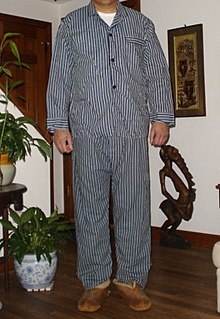
Pajamas (or pyjamas in Commonwealth English, (/pəˈdʒɑːməz, pɪ-, -ˈdʒæ-/ pə-JAH-məz, pih-, -JAM-əz)) are several related types of clothing worn as nightwear or while lounging. Pajamas are soft garments derived from the South-Asian Muslim bottom-wear, the pyjamas, which were adopted in the Western world as nightwear.
The garments are sometimes colloquially referred to as PJs, jammies, jim-jams or in South Asia, night suits.
Etymology
According to the Oxford English Dictionary, the word pajama is a borrowing via Urdu from Persian. Its etymology is:
Urdu pāy-jāma, pā-jāma and its etymon Persian pāy-jāma, pā-jāma, singular noun < Persian pāy, pā foot, leg + jāma clothing, garment (see jama n.1) + English -s, plural ending, after drawers.
History

The worldwide use of pajamas (the word and the clothing) outside the Indian subcontinent is the result of adoption by British colonists in the Indian subcontinent in the 18th and 19th centuries, and the British influence on the wider Western world during the Victorian era. Pajamas had been introduced to England as "lounging attire" as early as the seventeenth century, then known as mogul's breeches (Beaumont and Fletcher) but they soon fell out of fashion. The word pajama (as pai jamahs, Paee-jams and variants) is recorded in English use in the first half of the nineteenth century. They did not become a fashion in Britain and the Western world as sleeping attire for men until the Victorian period, from about 1870.
Hobson-Jobson: A Glossary of Colloquial Anglo-Indian Words and Phrases (1886) summarizes the state of usage at the time (s.v. "pyjammas"):
Such a garment is used by various persons in India e.g. by women of various classes, by Sikh men, and most by Mohammedans of both sexes. It was adopted from the Mohammedans by Europeans as an article of dishabille and of night attire, and is synonymous with Long Drawers, Shulwaurs, and Mogul-Breeches It is probable that we English took the habit like a good many others from the Portuguese. Thus Pyrard (c. 1521) says, in speaking of Goa Hospital: "Ils ont force caleçon sans quoy ne couchent iamais les Portugais des Indes" The word is now used in London shops. A friend furnishes the following reminiscence: "The late Mr. B—, tailor in Jermyn Street, some on 12 years ago, in reply to a question why pyjammas had feet sewn on to them (as was sometimes the case with those furnished by London outfitters) answered: "I believe, Sir, it is because of the White Ants."
Types
Traditional
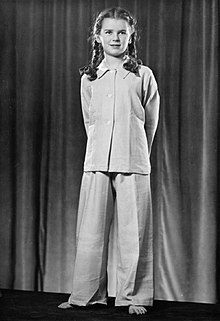
Traditional pajamas consist of a shirt-and-trousers combination made of soft fabric, such as flannel or lightweight silk. The shirt element usually has a placket front and sleeves with no cuffs.
Pajamas are usually worn as nightwear with bare feet and without undergarments. They are often worn for comfort by people in their homes, especially by children, especially on the weekend.
Contemporary

Contemporary pajamas are derived from traditional pajamas. There are many variations in style such as short sleeve pajamas, pajama bottoms of varying length, and pajamas incorporating various non-traditional materials. Often, people of both sexes opt to sleep or lounge in just pajama pants, usually with a t-shirt. For this reason, pajama pants are often sold as separates. Stretch-knit sleep apparel with rib-knit trimmings are common, mostly with young children.
Although pajamas are usually distinguished from one-piece sleeping garments such as nightgowns, in the US, they have sometimes included the latter or a somewhat shorter nightshirt as a top. Some pajamas, especially those designed for infants and toddlers, feature a drop seat (also known as a trap door or butt flap): a buttoned opening in the seat, designed to allow the wearer conveniently to use a toilet.
Fire safety
In the United States, pajamas for children are required to comply with fire safety regulations. If made of flammable fabric, such as cotton, they must be tight fitting. Loose-fitting pajamas must be treated with a fire retardant. Regulations in the United Kingdom are less stringent; pajamas which do not comply with fire safety standards may be sold, but must be labelled "KEEP AWAY FROM FIRE".
Society and culture

Pajamas in the Western world have been regarded as essentially indoors wear, or wear for the home, whether treated as daywear or nightwear.
When Bette Davis wore her husband's pajama top as a nightie in the 1956 film Old Acquaintance, it caused a fashion revolution, with I. Magnin selling out of men's sleepwear the morning after the movie opened, and all of it to young women.
Since the late 18th century some people, in particular those in the US and to some extent Britain, Ireland, Australia, and New Zealand, have worn pajamas in public for convenience or as a fashion statement.
One reason for the increased wearing of pajamas in public is that people no longer face the same social pressure as in the past.
In January 1976, the gulf emirate Ras Al Khaimah, UAE introduced a strict dress code for all local government workers forbidding them from wearing pajamas to work.
In January 2016, the Tesco supermarket in St Mellons, Cardiff, United Kingdom, started a ban on customers wearing pajamas.
In May 2010, Shanghai discouraged the wearing of pajamas in public during Expo 2010.
In January 2012, a local Dublin branch of the Government's Department of Social Protection advised that pajamas were not regarded as appropriate attire for clients attending the office for welfare services.
Many school and work dress codes do not allow pajamas. In 2020, due to the COVID-19 pandemic, an Illinois school district set remote learning guidelines which state that pajamas should not be worn while studying remotely and students should follow the same dress code as they normally would at school.
Schools sometimes designate a "pajama day" when students and staff come to school in their pajamas to boost school spirit.
In movies and television, characters are often depicted wearing pajamas in bed, as a more proper alternative to other forms of nightwear. These are commonly pajama pants with a shirt or t-shirt.
Gallery
-
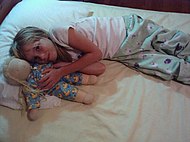 Girl in short-sleeve pajamas, doll in traditional.
Girl in short-sleeve pajamas, doll in traditional.
-
 Boys in stretch-knit pajamas.
Boys in stretch-knit pajamas.
-
 Toddler in footed pajamas.
Toddler in footed pajamas.
-
 Courier in white pajamas, India, 1844.
Courier in white pajamas, India, 1844.
-
 Men in white pajamas with hunting cheetahs, India 1844.
Men in white pajamas with hunting cheetahs, India 1844.
-
 Muslim men in pajamas (various styles), Bombay, 1867
Muslim men in pajamas (various styles), Bombay, 1867
-
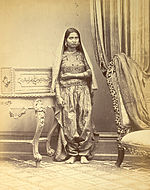 Muslim woman, in Sind, India, in salwar-style pajamas, 1870.
Muslim woman, in Sind, India, in salwar-style pajamas, 1870.
-
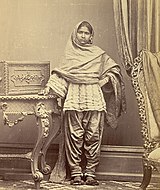 Hindu woman, in Sind, India, in shalwar-style pajamas, 1870.
Hindu woman, in Sind, India, in shalwar-style pajamas, 1870.
-
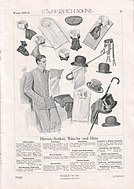 German advert with genuine English "Schlafanzüge (Pyjamas)", 1910
German advert with genuine English "Schlafanzüge (Pyjamas)", 1910
-
 1953 American advert for his and hers day pajamas, I Love Lucy-style
1953 American advert for his and hers day pajamas, I Love Lucy-style
-
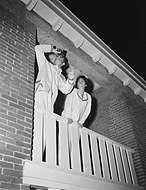 A Dutch couple viewing Sputnik 1,1957
A Dutch couple viewing Sputnik 1,1957
-
 Yves Saint Laurent Rive Gauche, c. 1970 (left), Halston, c. 1976 (right)
Yves Saint Laurent Rive Gauche, c. 1970 (left), Halston, c. 1976 (right)
See also
References
- "PJs". Dictionary.com.
- "Jammies". Dictionary.com.
- "pyjamas or pajamas, n.", Oxford English Dictionary (3 ed.), OED Online, 2022, retrieved May 2, 2022
- Lewis, Ivor. 1991. Sahibs, Nabobs and Boxwallahs: A Dictionary of Words of Anglo-India. Oxford: Oxford University Press. 266 pages. ISBN 0-19-564223-6. "They were introduced in England as lounging attire in the 17th century but soon went out of fashion. About 1870 they reappeared in the Western world as sleeping attire for men, after returning British colonials brought (them) back ...."
- Yule, Henry; Burnell, A.C. (1886). Hobson-Jobson: A Glossary of Colloquial Anglo-Indian Words and Phrases. p. 748.
Hobson-Jobson glosses "white ants" as "The insect (Termes bellicosus of naturalists) not properly an ant, of whose destructive powers there are in India so many disagreeable experiences, and so many marvellous stories.
- "Harriet Traynham (R) and her guests still wearing their pyjamas at 3:15 pm," Life magazine, August 1951 (Photographer: Lisa Larsen)
- "Children's Sleepwear Regulations". U.S. Consumer Product Safety Commission. July 16, 2016.
- Tyler, Danise (May 27, 2011). "Children's Clothes and Fire Safety". www.safekids.co.uk.
- PELA, ROBRT L. (February 15, 2016). "Stop Wearing Pajamas in Public — Now". Phoenix New Times.
- "Now they're shopping in pyjamas in Shanghai!". Liverpool Echo. January 17, 2009.
- Pidd, Helen (January 28, 2010). "Tesco bans shopping for bananas in pyjamas ... or bare feet". The Guardian.
- Hoevel, Ann (February 19, 2014). "Pajamas in public: The battle of 'appropriate' vs. 'comfy'". CNN.
- "Pyjama ban for UAE civil servants". BBC News. December 21, 2006.
- "Tesco ban on shoppers in pyjamas". BBC News. January 28, 2010.
- Yubin, Gao (May 14, 2010). "The Pajama Game Closes in Shanghai". The New York Times.
- "Meanwhile, In Blanchardstown". Broadsheet.ie. January 24, 2012.
- Wright, Will (August 8, 2020). "No Pajama Pants Allowed While Learning From Home, Illinois District Says". The New York Times. ISSN 0362-4331.
- Li, David K. (August 7, 2020). "Pajamas ban for students learning from home draws mixed response". NBC News.
- Chiang, Sylvia (March 25, 2015). "Pajama and other spirit days mean a better school climate, says Classroom Insider". Metroland Media Group.
External links
| Clothing | |||||||||
|---|---|---|---|---|---|---|---|---|---|
| Headwear | |||||||||
| Neckwear | |||||||||
| Underwear and lingerie |
| ||||||||
| Tops | |||||||||
| Bottoms |
| ||||||||
| Full-Body Wear |
| ||||||||
| Coats and outerwear |
| ||||||||
| Nightwear | |||||||||
| Swimwear | |||||||||
| Legwear | |||||||||
| Footwear | |||||||||
| Accessories |
| ||||||||
| Dress codes |
| ||||||||
| Related | |||||||||
| Nightwear | |
|---|---|
| Tops |
|
| Bottoms | |
| Full body |
|
| Hats | |
| Related topics | |